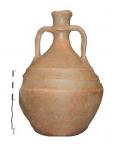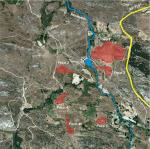Summary (English)
Intensive survey was carried out in an area of 20 hectares in this large archaeological site in the Sierra de Ávila, near the source of the river Almar. It had previously been known that there was a collection of 30 tombs carved into the rock and slab tombs in this site. However, the survey identified a set of 81 tombs concentrated in 5 areas, located in different points on both sides of the river. There are 72 tombs carved into the rock, with a variety of different types, although most of them are tomb tubs, and there are also 9 slab tombs. The latter, located in “site 2”, form a compact and aligned group, whereas in the rest of the cases there is an apparently chaotic pattern.
Due to the risk of damage of some slab tombs located near a path that runs through the site, permission to excavate some of them was requested and granted. 5 tombs located in “site 2” were excavated (tombs 20, 22, 23, 24 and 40). Only some sherds, evidence for some kind of grave goods, were recovered. Soil acidity made it impossible to find any skeletal remains. Moreover, during some cleaning practices in 2002, a little set of pieces of grave goods was recovered from a slab tomb (T23), comprising a little jug-bottle, a bronze ring and a bracelet. The grave goods may be dated to the 7th century or even later, although the practice of burial with grave goods doesn’t seem to have taken place after that century. For this reason, the group of slab tombs might be dated to that century. The use of the area as a necropolis may have lasted for a longer period of time, although not beyond the moment when parishes, with their parish cemeteries, are founded, which in that area must have happened around 1200.
Previous surveys had already confirmed the presence around “site 2” of an ash-colored archaeological level with fragments of common wheel-made pottery, elaborated with reduction firing. These fragments are widely dispersed around the area. During the intensive survey some fragments were identified, which presented wavy ‘comb’ incised decoration on the exterior surface, which had previously been polished. Dating these ceramics is difficult, but they could belong to the post-Roman period or to the Early Middle Ages.
Finally, in the transition area between the tombs in “site 1” and those in “site 2”, a series of foundations of possible housing structures was documented. Up to 5 structures were clearly identified, some of them subdivided into two rooms.
(translation by Laura González Fernández)
- Iñaki Martín Viso
Director
- Iñaki Martín Viso (Uniersidad de Salamanca)
Team
- Blas Cabrera González (Castellum S. Coop.)
- Jorge Díaz de la Torre (Castellum S. Coop.)
- Mª de los Reyes de Soto García
- Jesús Caballero Arribas (Arqueólogo Profesional. Castellum S. Coop.)
- María Sánchez Aparicio
Research Body
- Universidad de Salamanca
Funding Body
- Secretaría de Estado de Investigación, Desarrollo e Innovación, Secretaría General de Ciencia, Tecnología e Innovación. Dirección General de Investigación Científica y Técnica, Ministerio de Economía y Competitividad, Gobierno de España






![Download [PDF]](/excavation/skins/fasti/images/results/download_sml.png)

